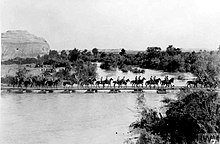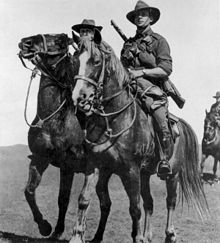5th Light Horse Brigade
| 5th Light Horse Brigade | |
|---|---|
Sinai and Palestine Campaign
| |
| Insignia | |
| Unit colour patch |  |
The 5th Light Horse Brigade was a mounted infantry brigade of the
History
Early formation
The 5th Light Horse Brigade was initially raised as part of the militia in the early 1900s, being formed sometime between 1902 and 1905. That formation was raised in
By 1912, however, an Army wide reorganisation resulted in the brigade's constituent regiments being redesignated. The 13th Light Horse became the 2nd Light Horse Regiment (QMI), the 14th became the 3rd (Darling Downs) Light Horse Regiment and the 15th was split to provide troops for the 1st (Central Queensland) Light Horse Regiment, 27th (North Queensland) Light Horse Regiment and 4th (Hunter River Lancers) Light Horse Regiment; the last of these was based in New South Wales. Most of these regiments were reallocated to the re-constituted 1st Light Horse Brigade, with the 27th becoming a divisional cavalry regiment. The 5th Light Horse Brigade designation was then re-used for a formation based in Victoria, consisting of the 13th (Gippsland) Light Horse Regiment, the 15th (Victorian Mounted Rifles) Light Horse Regiment and the 16th (Indi) Light Horse Regiment.[1]
World War I


At the outbreak of the war August 1914 the Australian Government decided to raise the
The 5th Light Horse Brigade was raised as an AIF formation late in the war, coming into being in Palestine in mid-1918 as part of the expansion and reorganisation of the

For the offensive in Palestine, the brigade was assigned to the Australian Mounted Division.[9][10][11] Prior to their commitment to operations, the troopers were converted from cameleers and were issued swords and received cavalry training.[12] Having been formed late in the war, the 5th Light Horse Brigade's involvement in combat operations was limited to the final offensive of the war, which began with the Battle of Megiddo in late September 1918. During this offensive, the brigade took part in the Battle of Sharon and Battle of Tulkarm, taking a large number of prisoners to the west of the Samaria Ranges.[13] During operations to secure Damascus, the brigade took up positions overlooking the Barada Gorge, helping to cut off withdrawing Ottoman and German troops, and inflicting heavy casualties on them during an ambush on 30 September.[14] The brigade then spent the night there in freezing conditions before elements entered Damascus on 1 October.[15][16] For the remainder of the month, it was engaged in minor mopping up and patrol operations before joining the final stage of the campaign, which saw the brigade begin the advance towards Aleppo. The advance was short lived, as on 30 October the Ottomans surrendered, and the Armistice of Mudros came into effect, bringing an end to the fighting in the theatre.[17][18][19]
Disbandment and perpetuation
In the final months of 1918, the demobilisation process began, and the brigade spent Christmas around Homs, in Syria.

Throughout late 1918 and early 1919, the process of demobilising the AIF continued, although this would not be complete until 1921.
In the first couple of years after the war, plans were made to reorganise the home forces to meet the needs of peacetime while providing a strong base upon which to mobilise if necessary. By 1921, when the AIF was officially disbanded, plans were approved to raise two cavalry divisions, each of three brigades, utilising a mix of voluntary enlistment and compulsory service.
Commander
During World War I, the brigade was commanded by the following officers:[16]
- Brigadier General George Macarthur-Onslow
Composition
During World War I, the brigade consisted of the following units and subunits:[29]
- 14th Light Horse Regiment
- 15th Light Horse Regiment
- 1er Régiment Mixte de Marche de Cavalerie du Levant (the cavalry element of the overall Détachement Français de Palestine et de Syrie), composed of two squadrons of French Chasseurs d'Afrique and one squadron of Spahis,[30][31][32][33] all three squadrons having arrived at Port Said on 19 March 1918. A fourth squadron and a machine gun platoon were despatched from the port of Bizerte, but their boat was torpedoed with the loss of all horses.[34]
- 2nd New Zealand Machine Gun Squadron
- 5th Signal Troop[10]
- B Battery, Honourable Artillery Company attached[8]
See also
References
Citations
- ^ a b Hall 1968, pp. 61–71.
- ^ Grey 2008, p. 85.
- ^ Bou 2010a, pp. 99 & 141.
- ^ Bou 2010a, pp. 145 & 163.
- ^ Hall 1968, pp. 43–45.
- ^ Bou 2010b, pp. 103–104.
- ^ Bou 2010b, pp. 103–105.
- ^ a b "5th Australian Light Horse Brigade". Australian Light Horse Studies Centre. 24 December 2009. Retrieved 8 January 2015.
- ^ Hall 1968, p. 74.
- ^ a b "5th Light Horse Brigade". Digger History. Retrieved 19 April 2009.
- ^ Mallett, Ross. "Mounted Troops". unsw.adfa.edu.au. Archived from the original on 25 March 2009. Retrieved 19 April 2009.
- ^ Perry 2009, p. 399.
- ^ Perry 2009, p. 427.
- ^ Bou 2010b, p. 136.
- ^ Perry 2009, pp. 455 & 458.
- ^ a b Hall 1968, p. 45.
- ^ a b "14th Light Horse Regiment". First World War, 1914–1918 units I. Australian War Memorial. Archived from the original on 7 October 2012. Retrieved 25 April 2009.
- ^ a b "15th Light Horse Regiment". First World War, 1914–1918 units. Australian War Memorial. Archived from the original on 7 April 2012. Retrieved 19 December 2011.
- ^ Bou 2010a, pp. 195 & 197.
- ^ "Homs, Syria, December 1918: C Squadron , 14th Light Horse Regiment". Australian War Memorial. Retrieved 27 July 2019.
- ^ Bou 2010b, p. 145.
- ^ "AWM4 10/5/12 – July 1919: 5th Light Horse Brigade". Australian Imperial Force unit war diaries, 1914–18 war. Australian War Memorial. Retrieved 28 July 2019.
- ^ Grey 2008, p. 125.
- ^ Bou 2010a, pp. 110–111.
- ^ Hall 1968, p. 75.
- ^ Hall 1968, p. 47.
- ^ Bou 2010a, p. 229.
- ^ Hall 1968, pp. 77–78.
- ^ Bou 2010b, p. 105.
- ^ Preston 1921, pp. 258–60, 335.
- ^ Heurley, Michel (28 April 2014). "A propos de la cavalerie du Levant" [About the cavalerie du Levant] (in French). Retrieved 29 July 2020.
- ^ Terraillon, Marc (16 April 2006). "Régiment mixte de Marche de Cavalerie du Levant" [Régiment mixte de Marche de Cavalerie du Levant at Nablus]. Forum pages14-18 (in French). Retrieved 29 July 2020.
- ^ "1er régiment mixte de marche de cavalerie [du Levant] du Détachement français de Palestine et Syrie: J.M.O. janvier 1918-septembre 1922 - 4 H 258/2" (JPG). Mémoire des hommes: Journaux des Unites (1914-1918) (in French). Ministere De la Defense. images 1 to 17 of 50. Retrieved 30 July 2020.
The first seventeen images cover the period from 29 Jan 1918 to 13 Nov 1918
- ^ Tournyol du Clos 1936, pp. 226–9.
Bibliography
- Bou, Jean (2010a). Light Horse: A History of Australia's Mounted Arm. Port Melbourne, Victoria: Cambridge University Press. ISBN 978-0-52119-708-3.
- Bou, Jean (2010b). Australia's Palestine Campaign. Australian Army Campaign Series # 7. Canberra, Australian Capital Territory: Army History Unit. ISBN 978-0-9808100-0-4.
- ISBN 978-0-521-69791-0.
- Hall, Richard John (1968). The Australian Light Horse. Blackburn, Victoria: W.D. Joynt & Co. OCLC 59504.
- ISBN 978-0-7336-2272-4.
- Preston, Richard Martin (1921). The Desert Mounted Corps: An Account of the Cavalry Operations in Palestine and Syria, 1917–1918. London: Constable. ISBN 978-1-14675-883-3.
- Tournyol du Clos, Alain, ed. (1936). "Chapitre VI: Renforcement du détachement français de Palestine". Les armées françaises dans la Grande guerre. Tome IX. 1er Volume. Théatre d'opérations du Levant. Ministère De la Guerre, Etat-Major de l'Armée - Service Historique (in French) (1st ed.). Paris: Imprimerie Nationale. Retrieved 30 July 2020.
Further reading
- OCLC 220624545.
External links
- 5th Light Horse Brigade war diary, Australian War Memorial
- The 1er Regiment Mixte de Marche de Cavalerie du Levant in miniature
